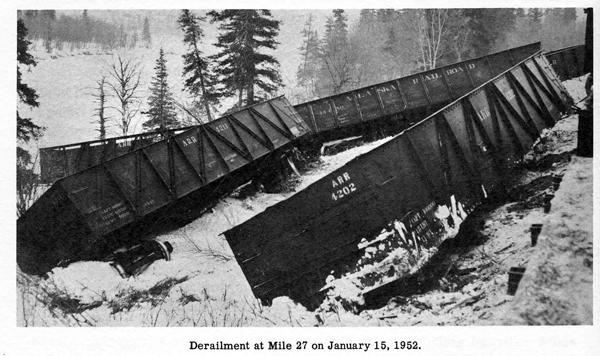
.
The 4200 class and 4250 class gondolas were not on the 1931 equipment circular
12A. They do appear on an undated Freight Equipment Summary from the early 1940s.
Gondolas 4250 - 4299 are reported as 47 units with no other description. In January 1952 there was a wreck of several Gondolas and in the left background can be found a partial image of ARR #4274. This is the only image and mention of these cars I have found.
A little detective work confirms this is a USRA composite drop bottom gondola A common car built with a steel frame and wooden sides and bottom, to conserve steel during the WW I.
Intermountain Railway Company offers Kit #41699 from which you can build the 4250 class.

I was fortunate to purchase a pair of N.C.&St. L Ready to Run cars at half price a few years ago. They have the correct Light Box Car Red color and all the data printed on the finished car. A little touch painting to cover the offending road name and numbers with PollyS matching paint and then application of the correct white ARR and car numbers completed the job.
Much of the appeal of this model is the drop bottom doors which are just hinted at in the Laser etched wood floor and sides. Careful weathering and painting will help define these details for a unique car. An overall alcohol wash with gray, was followed by replacing some broken boards and distressing some others with new wood paint. The steel parts were highlighted first with loco black and rust and finally burnished with a #2 pencil lead to show some abrasion from the coal load.
The drop doors were hinged at the car edge and opened from the center. They could be chained up to dump between the rails for ballast work. As you can see, the eight doors still left lots of dirty work for a crew with shovels to work material out of the corners. In the early years gondolas were used for shipping coal and were unloaded by stiff leg cranes or locomotive cranes with clam shell buckets. The drop bottom cars were much more efficient when used at facilities like the power plant in Anchorage that had a trestle raised tipple where these cars and hoppers could be emptied.
So we conclude that the 4250 class cars were built in the late teens or twenties, came to Alaska in the thirties, were still around in 1952 and then all disappeared before the 1963 roster was published. They are appropriate in an Alaska RR consist with any vintage steam locomotive and right through the first generation diesels turning blue and gold.
These models are inexpensive and a couple of evenings work will
give great results.